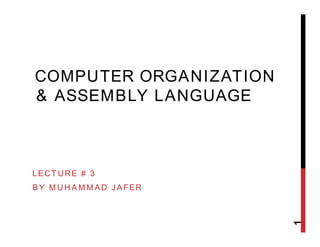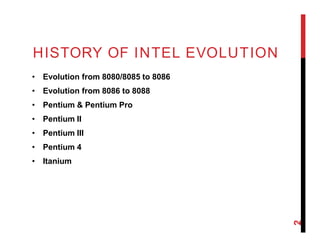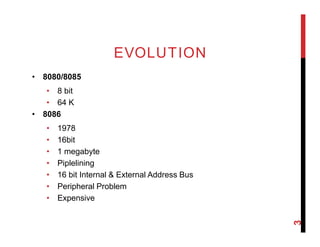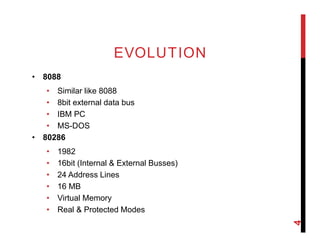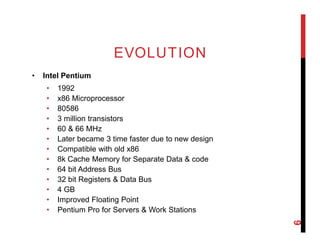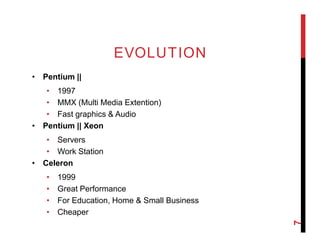Coal 3 history of intel evolution in Assembly Programming
- 1. COMPUTER ORGANIZATION & ASSEMBLY LANGUAGE LECTURE # 3 BY MUHAMMAD JAFER 1
- 2. HISTORY OF INTEL EVOLUTION • Evolution from 8080/8085 to 8086 • Evolution from 8086 to 8088 • Pentium & Pentium Pro • Pentium II • Pentium III • Pentium 4 • Itanium 2
- 3. EVOLUTION • 8080/8085 • 8 bit • 64 K • 8086 • 1978 • 16bit • 1 megabyte • Piplelining • 16 bit Internal & External Address Bus • Peripheral Problem • Expensive 3
- 4. EVOLUTION • 8088 • Similar like 8088 • 8bit external data bus • IBM PC • MS-DOS • 80286 • 1982 • 16bit (Internal & External Busses) • 24 Address Lines • 16 MB • Virtual Memory • Real & Protected Modes 4
- 5. EVOLUTION • 80386 • 1985 • 32bit (Internal & External Busses) • 4GB • Virtual Memory to 16TB • Math CoProcessors • 386SX • 80386 • 16 bit External Data Bus • 24 bit Address Bus • 16 MB • Cheaper • Cache Memory 5
- 6. EVOLUTION • Intel Pentium • 1992 • x86 Microprocessor • 80586 • 3 million transistors • 60 & 66 MHz • Later became 3 time faster due to new design • Compatible with old x86 • 8k Cache Memory for Separate Data & code • 64 bit Address Bus • 32 bit Registers & Data Bus • 4 GB • Improved Floating Point • Pentium Pro for Servers & Work Stations 6
- 7. EVOLUTION • Pentium || • 1997 • MMX (Multi Media Extention) • Fast graphics & Audio • Pentium || Xeon • Servers • Work Station • Celeron • 1999 • Great Performance • For Education, Home & Small Business • Cheaper 7
- 8. EVOLUTION • Pentium III • 1999 • New Instruction for • SIMD (Enhance Video & Audio) • Pentium ||| Xeon • Servers • Work Station • Pentium 4 • 1999 • New Design Called Net Brust • New Instruction for Video & Audio. • Increase Speed of Buses & Processors 8
- 9. CHAPTER REVIEW • The x86 PC Assembly Language, Design & Interfacing • Chapter # 1 • The x86 Processor • Brief History of the x86 family 9

